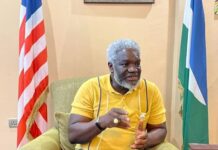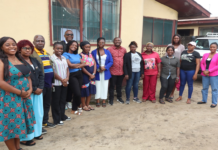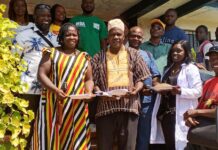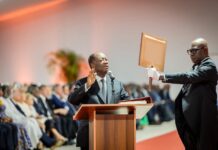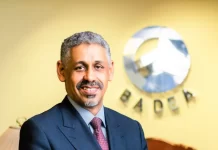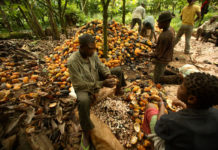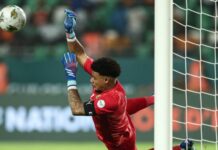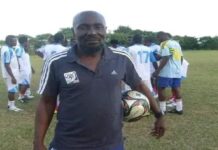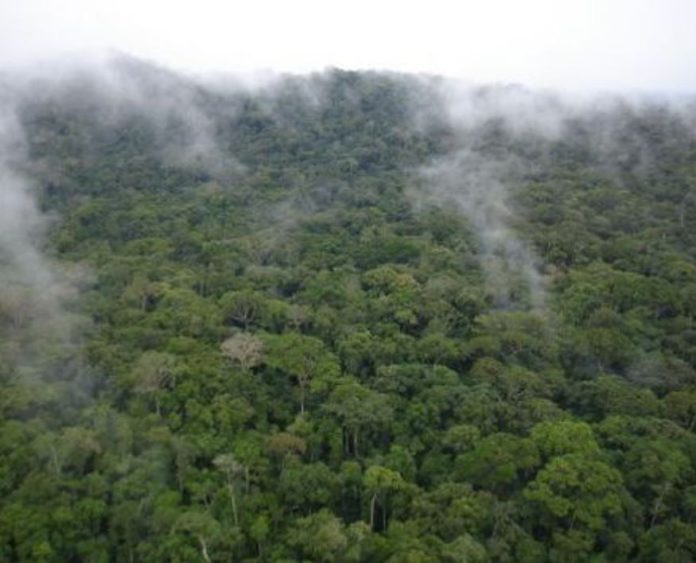
By Chaz Kyser|Communication Manager WABICC project
Building on the governments of Sierra Leone and Liberia’s commitment to protect the Gola Transboundary Forest Landscape, officials representing the two West African countries gathered on February 18, 2020 at Liberia’s Ministry of Foreign Affairs in Monrovia to sign amendments to their current memorandum of understanding (MOU) regarding the conservation of this shared resource.
The forest landscape, also known as the Gola Transboundary Peace Park, is home to the Gola Rainforest National Park in Sierra Leone and the Gola Forest National Park in Liberia.
Together, the forests span more than 350,000 hectares and represent one of the largest remaining blocks of the Upper Guinea Forest.
Recognized as a biodiversity hotspot, these shared forests are home to more than 899 vascular plants, 49 mammals, 327 bird species, and 43 amphibians. Unfortunately, many of the wildlife and plants are threatened or critically endangered, including the forest elephant, West African chimpanzee, western red colobus monkey, pygmy hippopotamus, and rosewood.
In 2011, the presidents of Sierra Leone and Liberia first signed an MOU on cooperation in the management, research, protection and conservation of their shared forest. However, much of the needed work by the Coordination Committee came to a standstill, most notably because of a lack of resources.
Understanding the importance of putting the MOU into action, the USAID-funded West Africa Biodiversity and Climate Change (WA BiCC) program has been a key partner to both countries in their quest to better protect the forest.
In 2018, WA BiCC supported a meeting of technical representatives to lay the groundwork for the first meeting of the Coordination Committee, which included the development of a draft work plan. In 2019, WA BiCC supported the first meeting of the Coordination Committee in Freetown, Sierra Leone, and later played a key role in reviewing the suggested amendments.
The recently signed amendments obligate Sierra Leone and Liberia to jointly share the management of the forest. Together, they will seek to curtail the main drivers of the forest’s continued deforestation, degradation, and biodiversity loss, including illegal hunting and poaching, mining, chainsaw logging, and shifting cultivation/agricultural encroachment. Unfortunately, those living in forest-edge communities often engage in such practices to sustain their way of life and for economic reasons.
Given this challenge, a key focus of both governments is working together and with various stakeholders to help forest-edge communities find alternative means to improve their livelihood without being a burden on animal and plant life.
“What we are about to witness today is a balancing . . . we have to preserve Gola forest, we have to preserve wildlife, but those who live in the communities around the forest, their lives also have to be improved,” said Gbehzohngar Findley, Foreign Minister of Liberia, touching upon this issue.

In addition to Findley, chief signatories of the amendments included Sierra Leone’s Deputy Minister of Agriculture, Sam-King Brima; Secretary-General of the Mano River Union, Medina Wesseh; Paramount Chief of Gola Rainforest National Park in Sierra Leone, Alameen Kanneh; and Paramount Chief of Kongba District, Gbarpolu County, John Try.
The signing ceremony for the amendments was also graced by representatives of regional and local partners, including the Economic Community of West African States, USAID West Africa, USAID Liberia, the European Union, and the Society for Conservation of Nature in Liberia.
Speaking on the significance of the signing ceremony, Sara Walter, Mission Director for USAID/Liberia, said, “It’s our hope that in the era of conflict around the world that we see today, the transboundary cooperation between Liberia and Sierra Leone to protect the Gola will continue to serve as a model across the region, and indeed, the continent.”
During many of the speeches preceding the signing, the important role that forest-edge communities play in the conservation and management of the forests was stressed.
“They have lived in these areas for centuries,” said Findley. “They know all the animals that are in the forest, they know all the trees that are in the forest, they know all the rivers that are in the forest, they know all the value for every leaf that exists in the forest—they are the traditional people and owners of the forest . . .We must charge them today with the responsibility to ensure that their communities continue to preserve the forest and wildlife.”
In turn, Paramount Chiefs Kanneh of Sierra Leone and John Try of Liberia reaffirmed their willingness to work with all stakeholders to preserve the forest, with the expectation that all parties involved would honor their commitments and chart a path together.
“This is an event, a very importance one, but the process that ensues out of this is what actually matters,” said Kanneh. “With this memorandum of understanding, I think it is geared toward understanding that our destinies our inextricably linked, that our futures are all the same, and that our children’s futures are at stake.”


